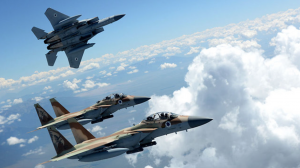
By Friday morning the empty bravado ended as Syria’s allies have stopped their reports of an alleged Israeli airstrike. – This may be to protect the Syrian alliance from embarrassment, having not used the advanced S-300, admitting what was destroyed during attack or by explaining the reported 34 Iranians eliminated in Kiswah.
On Thursday night social media accounts that follow Syria lit up with reports of airstrikes south of Damascus. SANA, the Damascus state media, claimed that “air defenses of the Syrian Arab Army responded to an aggression on the southern region” and had prevented the attack from achieving objectives. However Syrian state media and allies of the Syrian regime have downplayed the incident in the twelve hours after it happened. From wild claims that the air defenses had down rockets and even a plane, Syria’s allies now appear to want to sweep the incident under the carpet. This may be to protect the regime from embarrassment.
A variety of social media accounts that support the Syrian government were active Thursday night, but many now seem disinterested in the aftermath. This is also true of Iranian media, which supports Syria, and media that tends to be pro-Hezbollah. On Thursday night some of these outlets, such as Al Mayadeen, showed images purportedly of air defenses over Damascus. Reports began around ten in the evening and continued for more than an hour. By midnight it was all over and what appeared to be a serious incident had gone quiet. Most of these reports followed the message from Damascus. “Our air defenses met hostile targets over the area of Al-Kiswah” and had intercepted the attack.

Side-by-side images show the Syrian facility before and after alleged Israeli airstrike. – Photo: ImageSat International
What’s particularly interesting is that none of the media sought to point fingers at who the aggressor was. In the past the Syrian regime has blamed Israel and the US. One of the only major accounts that have kept on the story is Sputnik News in Arabic, a Russian channel. Russia supports the Syrian regime. On Friday Sputnik claimed that shrapnel from Syrian air defenses was found on the Golan Heights. It based its report on an announcement from Israel. Sputnik also noted that Syrian air defense had used the S-200, not the more advanced S-300 system that Russia supplied to Syria in October and which the Syrians are still being trained to use. Sputnik also reported that Syrian officials told them the S-300 was not used.

Russian Air Force transport planes unload newly acquired S-300 missile systems in Syria – Screenshot: Russian video release.
This was a major climb-down from Thursday night when the same news channel had tweeted reports that Syrian air defense intercepted four cruise missiles and a jet that was involved in the attack. By Friday morning, all those reports had stopped. Iranian media also did not report heavily on the incident. Tasnim entirely ignored it. Fars News did the same. PressTV claimed Syria had downed targets over Damascus. However PressTV also made sure to emphasize that it was unclear if the S-300 had been used and noted that a “military source [in Syria] did not specify the targets but dismissed reports that an Israeli plane had been downed.”
Al-Masdar News published images of what it said were the remains of projectiles that fell south of Damascus. These might have been pieces of incoming missiles or of Syrian air defense. Babak Taghvaee, a social media user who has expertise on air defense and follows conflict in the region, claimed Syria used Pantsir 57E6 air defense missiles and S-200s against the attack “scoring at least 3 kills on Delilah cruise missiles.”
The decision to downplay Thursday’s airstrikes, after initially hyping them, clearly indicates that Damascus wants to save face. It didn’t use the S-300, or if it did it found the system was ineffective at interdicting the strike. It wants to therefore highlight its use of the older air defense system, which has been ineffective in the past at defending Damascus. Russia is busy at the G20 and dealing with a crises with Ukraine over navigation of the Kerch Straits. This means that Syria’s main ally is distracted by other issues. Russia has condemned attacks on Syria in the past and has warned against any “hot heads” carrying out air raids. But Russia has been mum about whatever happened on Thursday night. RT and Tass news agencies both lack reports about the attack. Syria’s Iranian ally is also quiet, indicating that Iran also knows that discussing the attack too much will lead to questions about Iran’s own activities in places like Kiswah, where the attack was reported. Kiswah was the site of an airstrike in May that the regime blamed on Israel. After an airstrike near Kisway in December satellite images showed damage to an alleged Iranian base.

Before (bottom left) & After (top left) photos of May 8th airstrike in Syria
Countries that oppose the Syrian regime have been more outspoken about the airstrikes. Turkey’s Anadolu news claimed that “Israeli airstrikes carried out inside Syrian territory on Thursday targeted positions held by the Damascus regime and allied militias backed by Iran.” Turkish media emphasized that the incident was the most serious since September when Syrian air defense downed a Russian IL-20 aircraft during an Israeli airstrike. That strike led Russia to send the S-300 and warn against further attacks. Al-Arabiya reported that “two senior security sources” told the Saudi outlet that the Kiswah site was used by Hezbollah and Iranian-backed militias. Jordan’s Al-Ghad and Kuwait’s Al-Jarida, had no reports about the Syrian incident.
View original The Jerusalem Post publication at:
https://www.jpost.com/Middle-East/Syrian-regime-and-allies-downplay-airstrikes-after-wild-night-in-Damascus-573219






 Israeli New Shekel Exchange Rate
Israeli New Shekel Exchange Rate